Siberian Husky is a beautiful and very popular dog breed but it is not easy to deal with this northern treasure.
Brief Characteristics of Siberian Husky:
Height: 20-23,5 inches (51-60 cm). Weight: 35-60 lbs. (16-27 kg). Health: robust. Lifespan: 12-14 years. Temperament: friendly, social, playful, alert, adventurous, obstinate.
Some dog breeds became famous and desired after just one event. That's exactly how it happened to Siberian Husky.
It was back in 1925 when the gold miners’ town of Nome in Northern Alaska suffered from a violent outbreak of diphtheria. The antitoxin serum was 674 miles (1,085 km) away. It was January, minus 54 degrees (- 48°C), very stormy, and all roads were impassable. The sole aircraft could not start, and only dog sleds were able to transport the serum.

The whole world followed the “Great Race of Mercy”. Two Siberian Huskies, 12-year-old Togo and black Balto, were selected as the lead dogs because of their experience and temperament. Togo took the first and the most hazardous leg of the five-and-a-half-day race, whereas Balto was the one who brought the medicine to 2000 habitats of Nome.
Both Siberian Huskies became national heroes: Balto got his own statues in New York City's Central Park and in downtown Anchorage, Alaska, and Togo became a symbol of the Lucky Strike cigarettes brand. Later on, Steven Spielberg has produced an animated film Balto about this tough serum run.
ON THIS PAGE:
Siberian Husky’s Origin and History
The history of the Siberian Husky begins much earlier. These dogs originate from the northeast of Russian Siberia, where they have been kept for centuries by the nomadic people there. The Chukchi tribes used them to pull heavy loads across frozen and vast terrain, to herd reindeer, to hunt, and to keep the children warm. These versatile dogs were able to cover long distances on very little food, and they were an integral part of everyday Chukchi life.
Due to the isolation of the Chukchi people, the breed remained pure for a long time. In 1909, Russian fur trader William Goosak brought these dogs to Alaska, where he entered them for the 400-mile "All Alaska Sweepstakes" sled dog race.
In the beginning, he was only smiled at because of the small size of his new dogs compared to the much larger and well-tried Alaskan Malamutes. After the run, the mood of the public has changed: Goosak’s team was third to cross the finish line. And the next year his Siberian dogs completely dominated in this popular race.

Photo Credit: Wild0ne/Pixabay
From that time, the professional breeding of the Siberian Husky began but the official recognition came to this breed much later. Despite its excellent characteristics and centuries of pure breeding, the breed was recognized only in 1938 in the USA (under the name “Arctic Husky”) and in 1966 in Europe. Both Russia and the United States like to lay claim to it but since the breeding started in Alaska, the USA is considered as the country of origin of the Siberian Huskies (in Russian, Sibirskiy Haski).
Appearance and Coat
The radiant blue eyes and the typical northern coat are for many the most striking features of a Siberian Husky.
The dog's thick coat is decisive in its activity as a sled dog and allows it to work and to feel comfortable even in temperatures as low as negative 75 degrees Fahrenheit (- 59°C).
Husky’s coat consists of two layers: the fine undercoat is mostly white or at least strongly whitish, and it completely renews once or twice a year. The rubbing together of the fine hairs during the dog’s movement generates frictional heat, which is stored by the topcoat above.
The topcoat is usually darker than the undercoat. The chest and belly are mostly white. Further towards the back, the color becomes stronger and can vary between red, grey, and black. Many Siberian Huskies also have a so-called colored "mask" on their head.
Siberian Husky Colors
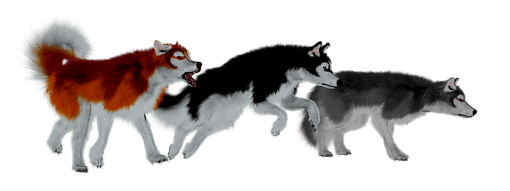
White, gray, silver, sable, gray and white, sable and white, red and white, black and white, red-orange with black tips.
Siberian Husky Blue Eyes
Husky’s almond-shaped eyes are in most cases of a pale blue color that makes this breed so recognizable. Beside the blue-eyed dogs, there are also Siberian Huskies with amber-colored eyes or even odd-eyed dogs, that have one blue and one brown eye.
… pale blue like the eyes of a Siberian Husky dog. Human beings just didn't have eyes like that.
Laurell K. Hamilton
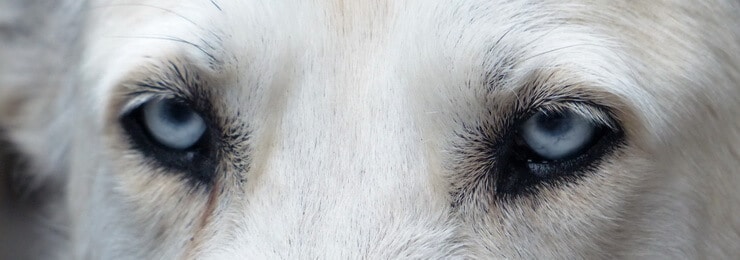
Photo Credit: Hans/Pixabay
Husky Tail
The rounded tail is well furred and looks like a round brush. It has an important purpose in extreme cold or snowstorms. A Husky, when curled up to sleep in a Siberian swirl, will cover its nose with its tail for warmth and to preheat the air.

Photo Credit: KiraHundeDog/Pixabay
Ears and Paws
The thickly hairy ears are moderate-sized, stand closely together, and are set on high.
The Husky’s paws are adjusted to the Siberian cold too. They are comparatively smaller than those of similarly sized dogs, which means that less heat is lost.
Generally speaking, the Siberian Husky is a medium-sized northern working dog, powerfully built and well-balanced, with moderate bone and freedom of movement.
It holds its head high, and with a height at withers of 50 to 60 centimeters, is not one of the dwarves.
Male Huskies are masculine but never coarse. The females of the breed are feminine and slightly smaller but not weakly built. If Husky is allowed sufficient movement by its owner, it is rarely overweight.
Siberian Husky Size
Height (at the withers)
Males: 21 – 23,5 inches (53 - 60 cm);
Females: 20 – 22 inches (51 - 56 cm).
Weight
Males: 45 - 60 pounds (20 - 27 kg);
Females: 35 - 50 pounds (16 - 23 kg).
Siberian Husky Temperament
The Siberian Husky has preserved its very original character which distinguishes this breed clearly from typical family and companion dogs. Hardly any other dog is as closely connected with its initial use. Husky is a master of sledding: it can pull nine times his body weight and has a superb sense of orientation even for a dog – a very important ability in snow-covered surroundings! It has an exceptionally strong urge to move and wants to run extensively every day.
Most representatives of this breed are quite independent dogs with a strong hunting instinct: Rabbit in sight - off you go! Some Siberian Husky ignore calls of the owner thereby.
This unrestrained drive for action, Husky’s independence, and its innate hunting instinct make it difficult to permanently control this dog. It is not possible with every Husky to educate it in such a way that it can be retrieved at any time without a leash.
Stubbornness is also one of its character traits, so you need a consistent upbringing with this breed.
They also need mental stimulation to prevent boredom and destruction, so be sure to provide your dog with plenty of interactive toys.
After so many years of pure breeding, Siberian Husky still has a strong resemblance to the wolf, and it howls and sings acoustically rather than barks.
On the other hand, Siberian Husky, nicknamed Husky or Sibe, is a very well-disposed and affectionate dog that is incredibly loyal to all family members. Raised by the Chukchi in a family setting, it usually behaves well and could be trusted with children.
The overall temperament of the Siberian Husky is friendly and gentle, but also independent and alert. Husky is fun-loving and playful, outgoing and adventurous, social and intelligent, high energy and obstinate.
As a husky pack mama of 3 (having had 4), I know the stubborn & hyper ways huskies can be challenging. But if you live for exercise, excitement & unpredictable fun; not to mention unconditional love, huskies are IT!
Julia Demanett/Twitter
Husky easily adapts to a new situation and gets along well with strangers. This dog is always looking for friends, and that could include a burglar. So, if you are looking for a guard or a farm dog, you should opt for a different breed.
- Are Siberian Huskies known to be Aggressive or Vicious?
- Will Siberian Husky Protect You from an Attacker?
Is Siberian Husky Right for Me?
The extraordinary appearance and the friendly, lively character of the Siberian Huskies have made these dogs very popular. If you are longing for a captivating, joyful, free-spirited friend, look to this dog.
However, every potential owner of a “Sibe” should thoroughly consider whether he can meet the specific temperament of a Husky as well as some other demands of this breed.
Please, please, please, please, don’t adopt a Husky unless you know what you’re getting yourself into or else they’ll end up right back at the shelter. They are very high-energy, stubborn breed and can be very difficult. So be prepared to put in A LOT of work!
Xochitl/Twitter
1/ Siberian Huskies are designed for a life in the cold and do not like to sit behind a warm stove. As their fur is oriented towards the polar regions, Huskies suffer from the heat more than other dogs and are not suited well for permanently warm regions. If you want to keep Siberian Huskies, you should be able to offer them either air-conditioned rooms or at least dark cool rooms in the house and shady corners in the garden.
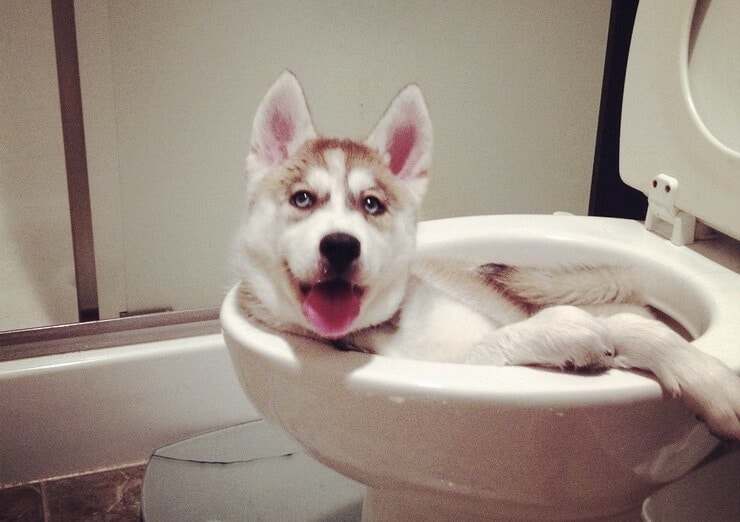
Photo Credit: Kona_Dlite/Reddit
2/ As Siberian Huskies should generally be kept at least in pairs and require a lot of exercises, they are not suitable for small city apartments. Huskies are most happy in a house with a large garden in a rural area, where their owner can take them for long walks or bike rides every day.
An escape-proof garden is very desirable for them so that they can keep moving between walks and running rounds. Just take into consideration that many Huskies like to dig holes under the fences. To prevent escaping and digging, fences should be solid wood at least 6 feet high, with a wire sunk into the ground along the fence.
Huskies get in trouble. Huskies are well-known to be escape artists. Why? Because they were bred to go long-distance. They're not bred to be in the backyard and just look beautiful because they have blue eyes. Cesar Millan
3/ The Siberian Husky is not a dog for Couch Potatoes. It wants to run and run, several hours a day and in the great outdoors. An underemployed Husky begins to get bored and seeks imaginative ways to keep itself busy. This could mean the end of furnishings, shoes, or well-groomed garden beds. There has even been a case of Siberian Husky chewing through a cement wall.
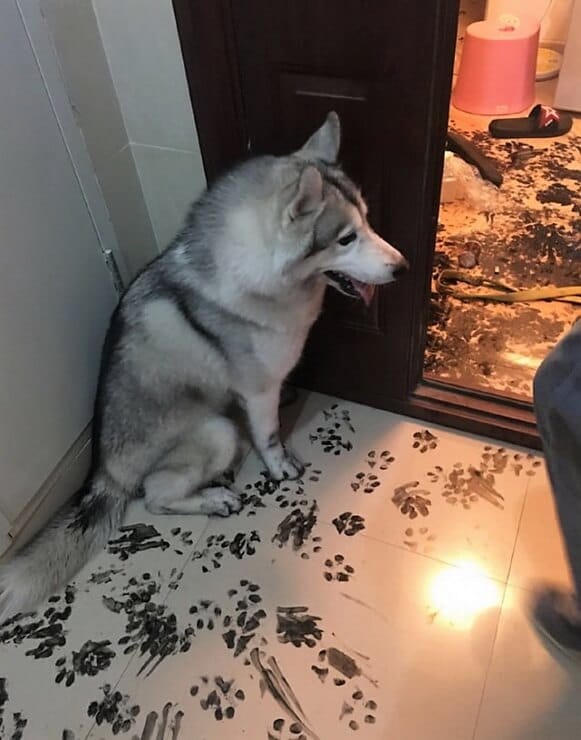
Photo Credit: RunningPoohinator/Imgur
4/ Cat lovers who wish to have a Husky, should get their dog used to cats when it is still a puppy because adult Huskies usually consider the cats as prey. It also concerns small dogs.
Where do I Get a Husky?
If you think that a Siberian Husky is your type of dog, it’s time to look for a puppy. The American Kennel Club is a good place to start your search for a responsible breeder.
The price of a Husky puppy varies from $500 to $1400 depending on the breeder’s locale, the titles of his parents, whether the pup is male or female, and whether he is best suited for work, dog shows, or just home.
You can also consider adopting an adult dog from an animal shelter. An adult Sibe may already have some training and will probably be less active, destructive, and demanding than a puppy.
A Husky will quickly turn you into a fool, but who cares? Better your Husky than your boss. I'm a fool for my Husky and proud of it.
Dave/Husky Owners forum
Health Issues
Wherever you get a Husky, take it to the veterinarian soon after adoption.
Normally, Siberian Huskies are quite healthy. Some potential health problems include defects of the eye like cataracts, corneal dystrophy, and glaucoma. They are also susceptible to tartar.
When buying from the breeder, make sure that the ancestors of your puppy have been tested for hip dysplasia.
Also, be sure to get your vet’s permission before exercising your Siberian Husky in warm temperatures.
Siberian Husky Lifespan
The average life expectancy of a Siberian Husky is from 12 to 14 years. Some Huskies live even longer.
Activities with the Siberian Husky
Today, Huskies can still compete very well in sled dog runs but they also became popular sporting and leisure companions. Just maintaining your own active life through outdoor sports will keep your Sibe healthy and happy. Most suitable sports for a Siberian Husky are bicycling, hiking, and jogging.
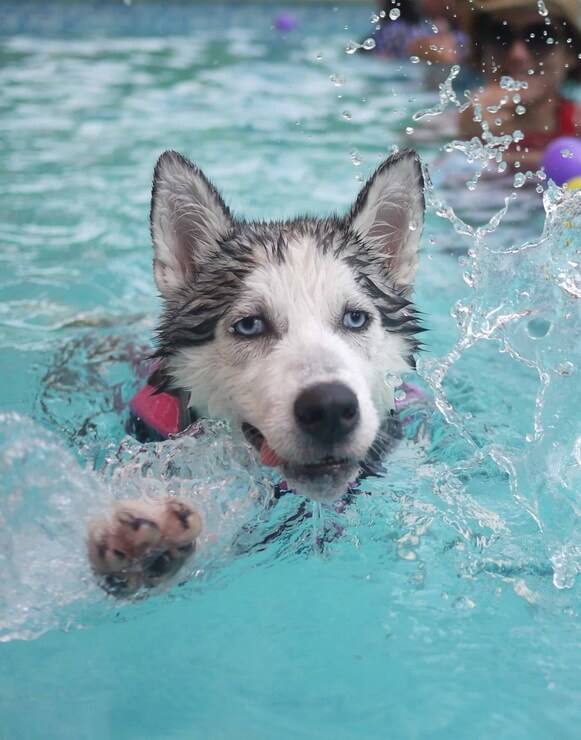
Photo Credit: iannnnn/Pixabay
As already mentioned, Huskies are enduring runners - even as family dogs they need a lot of exercise. A full-grown Husky likes to trot alongside your bike, appreciates long and extensive walks or jogging - especially on cooler days. If you are still enthusiastic about the first autumn winds, your Siberian Husky will gladly share your affection with you.
In summer, however, Husky owners should make these activities shorter in terms of movement and also provide cool places for rest.
Freestyle Dog Dancing and Agility are not what Huskies are especially good at. Find out what your dog enjoys and what he can do for himself.
Training a Husky
Early socialization and positive training are important for the Siberian Husky to maintain a happy, well-balanced, and well-behaved dog.
The committed owner can, of course, obedience train them, but this could be a challenge because the strong-willed Siberian Husky is inclined to use its intelligence for own purposes. This dog will only obey commands that make sense to it.
God knows I love this dog but Huskies have got to be the smartest dumbest dogs I’ve seen. I mean the lights are on but no one is home. I think training this guy is going to be next to impossible. He does not listen at all. Eats anything he can get ahold of (not just food, anything, and everything) Gets on my counters, takes food out of people’s hands. He is ridiculous. And, believe me, we are trying to train him. But what do you do when he is 24/7 mischief and does not listen or even care to follow commands! I’m beginning to wonder if he is not deaf. I mean I know he’s not because he can hear the treat jar lid from across the house no problem. And the vet says he’s perfect. I know Huskies are stubborn. But I do not know how to get through to this guy!!! Help!!!!!! I have never had a dog this stubborn and hard to train. But he’s sooooo adorable!!
Kathy/Facebook
First of all, you will have to teach your Siberian Husky to respect you and become a leader to your dog. To achieve this aim, you need to be calm, knowledgeable and use only motivational training methods. Yes, it can be painstaking, but worth the effort.
When trained well and exercised thoroughly, the Siberian Husky can become a really great companion for you and your family.

Buy Siberian Huskies For Dummies on Amazon (#ad)
Husky as a Therapy Dog
Due to its gentle nature and innate friendliness, Husky can become a good therapy dog. Of course, the individual character is important in this case. There are also many Huskies on duty in the ambulance service.
Siberian Husky Care
The care of a Siberian Husky is not difficult. Their shorter coat is less prone to mattes than the coats of other northern dogs. It is easy to comb, but you should do this frequently, especially during the change of coat, because during this period the northern beauties lose an incredible amount of hair.
There’s no need to wash your four-legged friend, most dirt can be simply combed or wiped away with a dry towel. If a bath cannot be avoided, it is best to use only water and mild dog shampoo.
I gave my husky a bath and well...
1) huskies are too damn stubborn
2) they have too much hair
3) he got out of the bath several times before it was even over
4) he shook all the water EVERYWHERE
5) no matter how long I dry his fur off, he’s still fucking wet
I love him tho
bailey martin/Twitter
Best Food for Siberian Huskies
The diet is of great importance for healthy dog life, and this is especially true for active dog breeds. Professional sled dog handlers know it very well: on training days their dogs get an extra portion of food.
Siberian Huskies are physically very active dogs, and at the best, they should get a diet consisting of one-third of vegetables and cereals and two-thirds of meat.
Basically, Husky does not eat differently from other breeds, and ready-made food makes sense because it provides your dog with all the necessary vitamins. It is advisable to always buy it fresh and in smaller quantities to prevent the food from losing its quality when stored open.
Especially with puppies, you should introduce fixed feeding times to which the body of the little ones can adjust. The younger the Husky puppies are, the more often they have to be fed. In the beginning - three to four times a day, later it can be shortened to two feedings.
It is important to use a special puppy food because puppies are very playful and need a lot of energy. A high-quality puppy food provides a balanced ratio of energy and minerals.
Many puppies prefer to eat what they have already got from the breeder. You can feed this for a while and later switch to adult food (possibly of the same brand). Otherwise, you have to try out what is good for your Husky and what it likes. Of course, what you finally choose depends on your budget too.
- How Much and What does a Siberian Husky Eat a Day?
- How Much Should I Feed my Siberian Husky Puppy?
- Best Dog Food for a One-Year-Old Siberian Husky?
Huskies are Better in Pairs
Many Huskies prefer garden life to life in the house, and, in this case, a second dog should definitely be present, because a Siberian Husky wants to have a "family connection". Loneliness for this breed means trouble. A lonely Husky will display a full range of undesirable behaviors.
Sled dogs are used to big packs and they don't like being alone. They often acknowledge this with howling, and this is an additional argument for a second dog in a Husky household.
Siberian Husky Mixes
Sibes are often bred with other dogs by their owners making a lot of Husky crossbreeds. Here’s just a small list of popular Husky mixes:
With German Shepherd - Gerberian Shepsky
With Samoyed - Husky Samoyed
With Alaskan Malamute - Alusky
With Labrador - Husky Lab
With Golden Retriever - Goberian
With Akita - Huskita
With Pug - Hug Dog
With Pitbull Terrier - Pitsky
With Corgi - Cusky
There are Siberian Husky x Belgian Malinois crossbreed, Siberian Husky x Border Collie crossbreed, and many others.
Siberian Husky Breed Names
Siberian Husky, Husky, Sibe, Sibirskiy Haski, Chukcha, Chuksha dog, Keshia, Arctic Husky, Russian: Сибирский хаски
Find a Russian name for your Siberian Husky!
Learn some Russian dog commands!


Leave a Reply